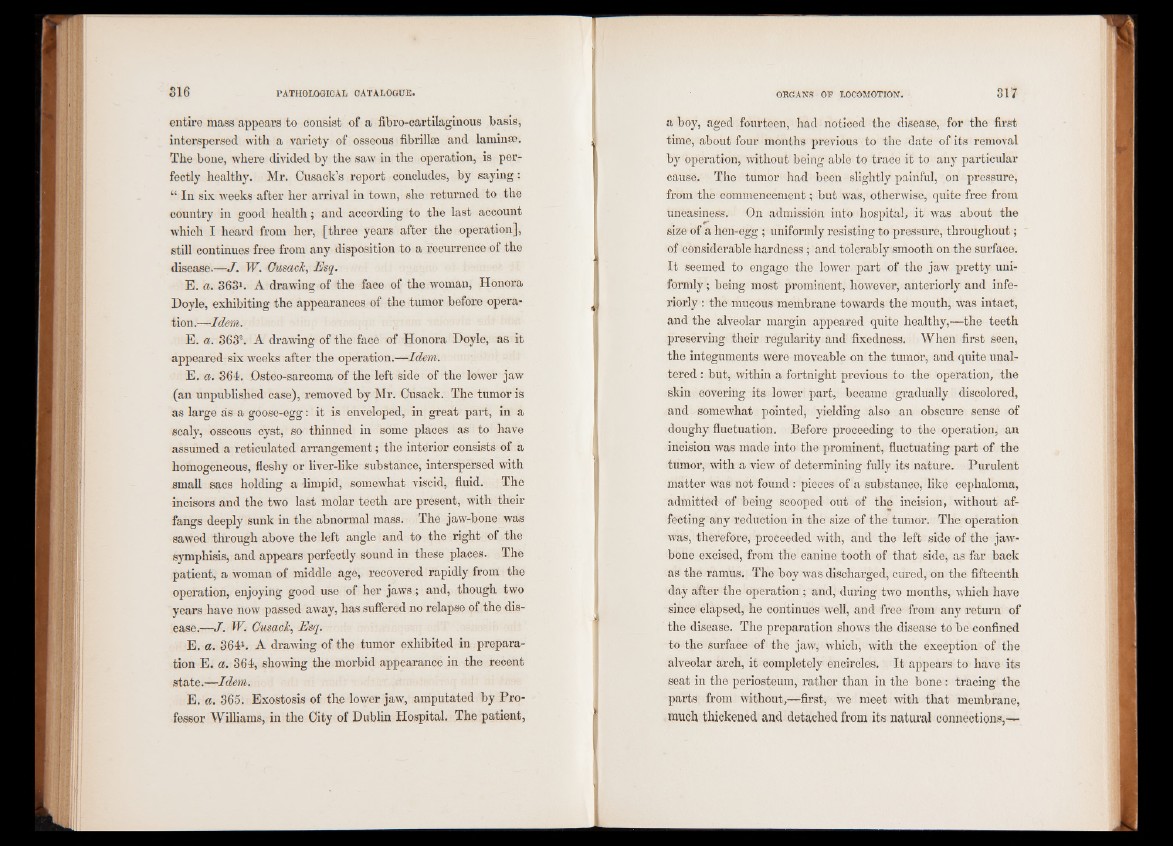
entire mass appears to consist of a fibro-cartilaginous basis,
interspersed with a variety of osseous fibrilke and laminae.
The bone, where divided by the saw in the operation, is perfectly
healthy. Mr. Cusack’s report concludes, by saying:
ft. In six weeks after her arrival in town, she returned to the
country in good health; and according to the last account
which I heard from her, [three years after the operation],
still continues free from any disposition to a recurrence of the
disease.—J. W. Cusack, Esq.
E. a. 3631. A drawing of the face of the woman, Honora
Doyle, exhibiting the appearances of the tumor before operation.—
Idem.
E. a. 363s. A drawing of the face of Honora Doyle, as it
appeared six weeks after the operation.—Idem.
E. a. 364. Osteo-sarcoma of the left side of the lower jaw
(an unpublished case), removed by Mr. Cusack. The tumor is
as large as a goose-egg: it is enveloped, in great part, in a
scaly, osseous cyst, so thinned in some places as to have
assumed a reticulated arrangement; the interior consists of a
homogeneous, fleshy or liver-like substance, interspersed with
small sacs holding a limpid, somewhat viscid, fluid. The
incisors and the two last molar teeth are present, with their
fangs deeply sunk in the abnormal mass. The jaw-bone was
sawed through above the left angle and to the right of the
symphisis, and appears perfectly sound in these places. The
patient, a woman of middle age, recovered rapidly from the
operation, enjoying good use of her jaws; and, though two
years have now passed away, has suffered no relapse of the disease.—
J. W. Cusack, Esq.
E. a. 3641. A drawing of the tumor exhibited in preparation
E. a. 364, showing the morbid appearance in the recent
state.—Idem.
E. a. 365. Exostosis of the lower jaw, amputated by Professor
Williams, in the City of Dublin Hospital. The patient,
a boy, aged fourteen, had noticed the disease, for the first
time, about four months previous to the date of its removal
by operation, without being able to trace it to any particular
cause. The tumor had been slightly painful, on pressure,
from the commencement; but was, otherwise, quite free from
uneasiness. On admission into hospital, it was about the
size of a hen-egg ; uniformly resisting to pressure, throughout;
of considerable hardness; and tolerably smooth on the surface.
It seemed to engage the lower part of the jaw pretty uniformly
; being most prominent, however, anteriorly and infe-
riorly : the mucous membrane towards the mouth, was intact,
and the alveolar margin appeared quite healthy,—the teeth
preserving their regularity and fixedness. When first seen,
the integuments were moveable on the tumor, and quite unaltered
: but, within a fortnight previous to the operation, the
skin covering its lower part, became gradually discolored,
and somewhat pointed, yielding also an obscure sense of
doughy fluctuation. Before proceeding to the operation, an
incision was made into the prominent, fluctuating part of the
tumor, with a view of determining fully its nature. Purulent
matter was not found : pieces of a substance, like cephaloma,
admitted of being scooped out of the incision, without affecting
any reduction in the size of the tumor. The operation
was, therefore, proceeded with, and the left side of the jawbone
excised, from the canine tooth of that side, as far back
as the ramus. The boy was discharged, cured, on the fifteenth
day after the operation ; and, during twTo months, which have
since elapsed, he continues well, and free from any return of
the disease. The preparation show's the disease to be confined
to the surface of the jawT, which, with the exception of the
alveolar arch, it completely encircles. It appears to have its
seat in the periosteum, rather than in the bone: tracing the
parts from without,—first, we meet with that membrane,
much thickened and detached from its natural connections,—